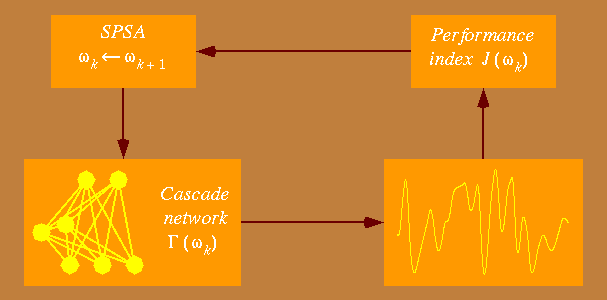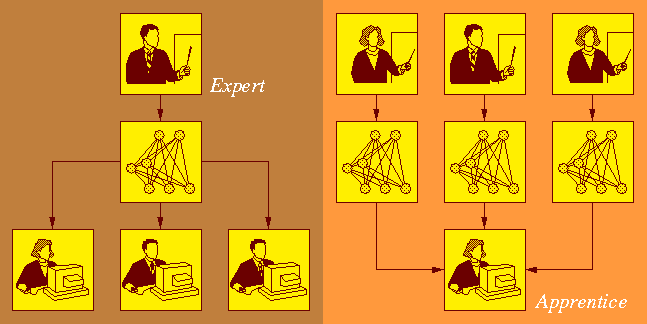|
|
|
|
|
|
|
|
 |  |
 Introduction
Introduction
We also evaluate the skill exhibited in
human control strategy and corresponding models through several
defined task-dependent as well as task-independent performance
criteria, including generalizability, long-term consistency, and
robustness. Using specific performance criteria, we then optimize performance in initially stable HCS
models through adaptive SPSA parameter refinement. One formulation of
the performance criteria allows us to simplify a model's structure
after training. Finally, we propose to use HCS models as virtual
teachers in
Scientific knowledge of human intelligence is not nearly advanced
enough to characterize human actions analytically. Therefore, in
modeling human control strategy (HCS),
as with other poorly understood phenomena, we must rely on modeling by
observation, or learning, rather than theoretical or physical
derivation. Human control strategy is dynamic, stochastic, possibly
discontinuous, and nonlinear in nature. To meet these challenges, we
model human control strategy using cascade neural
networks with variable activation functions. We have demonstrated
the applicability of cascade networks to modeling HCS in an inverted pendulum simulator and a driving simulator.

 Learning human control strategy (HCS)
Learning human control strategy (HCS)

A cascade neural network grows in complexity as is required by the training data.

|
Similarity analysis & model validation |

|
|
| The main strength of modeling by learning, as required for human control strategies, is that no explicit physical model is required; this also represents its biggest weakness, however, especially when the unmodeled process is (1) dynamic and (2) stochastic in nature, as is the case for human control strategy. For such processes, model errors can feed back on themselves to produce trajectories which are not characteristic of the source process or are even potentially unstable. Yet, most learning approaches today, including feedforward neural networks, utilize some static error measure as a test of convergence for the learning algorithm. While this measure is very useful during training, it offers no guarantees, theoretical or otherwise, about the dynamic behavior of the resulting learned model. Thus, we have developed a similarity measure, based on Hidden Markov Model analysis, as a means of validating learned models of human control strategy. | |

|
|
| We are primarily interested in generating a probabilistic similarity measure between the dynamic system trajectories generated by the human and those generated by the learned HCS models (i.e. the cascade network models). The diagram below illustrates the overall approach. We generate normalized probabilities P1 and P2 for the HMM trained on the human control data. The relationsip between these normalized probabilites defines the similarity measure. As an example, we have applied this validation procedure to the learning of human driving. | |

|

 Input
selection
Input
selection

 Skill
evaluation
Skill
evaluation(a) (b)

Stan's stability profile (a), and Oliver's stability profile (b), where orange and yellow colors indicate a successful maneuver through the s-curve, the red indicates a marginally successful maneuver, and the brown indicates an unsuccessful maneuver.

 Performance
optimization
Performance
optimization
 Human-to-human skill transfer
Human-to-human skill transfer

| [1] | M. Nechyba and Y. Xu, Stochastic Similarity for Validating Human Control Strategy Models, Proc. IEEE Conf. on Robotics and Automation, vol. 1, pp. 278-83, 1997. | |
| [2] | M. Nechyba and Y. Xu, Human Control Strategy: Abstraction, Verification and Replication, to appear in IEEE Control Systems Magazine, 1997. | |
| [3] | M. Nechyba and Y. Xu, On the Fidelity of Human Skill Models, Proc. IEEE Int. Conference on Robotics and Automation, vol. 3, pp. 2688-93, 1996. | |
| [4] | M. Nechyba and Y. Xu, Human Skill Transfer: Neural Networks as Learners and Teachers, Proc. IEEE Int. Conference on Intelligent Robots and Systems, vol. 3, pp. 314-9, 1995. | |
| [5] | M. Nechyba and Y. Xu, Neural Network Approach to Control System Identification with Variable Activation Functions, Proc. IEEE Int. Symp. on Intelligent Control, vol. 1, pp. 358-63, 1994. | |
| [6] | M. Nechyba and Y. Xu, Stochastic Similarity for Validating Human Control Strategy Models, Technical Report, CMU-RI-TR-96-29, Carnegie Mellon University, 1996. | |
| [7] | M. Nechyba and Y. Xu, Towards Human Control Strategy Learning: Neural Network Approach with Variable Activation Functions, Technical Report, CMU-RI-TR-95-09, Carnegie Mellon University, 1995. |